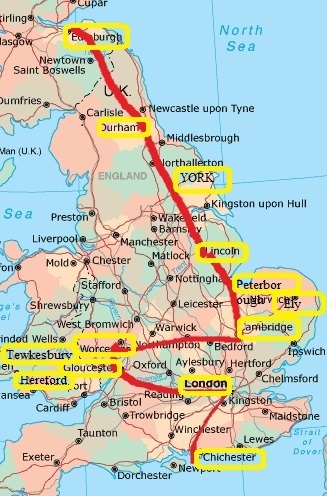U.K. 2013
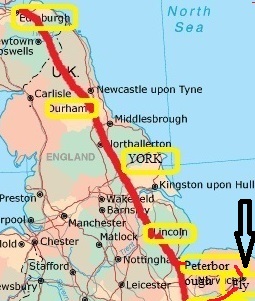
Day 11, Friday
September 13, 2013
ELY
We got up early again and went up to breakfast/dining room. There was
wonderful view of the Lincoln Cathedral with our good breakfast.
We took
a taxi to the train station for a 10:00 train for Eli. We had to change
trains in Peterborough. Our first train was 3 cars, the second on was
only 1 car with about 60 seats. It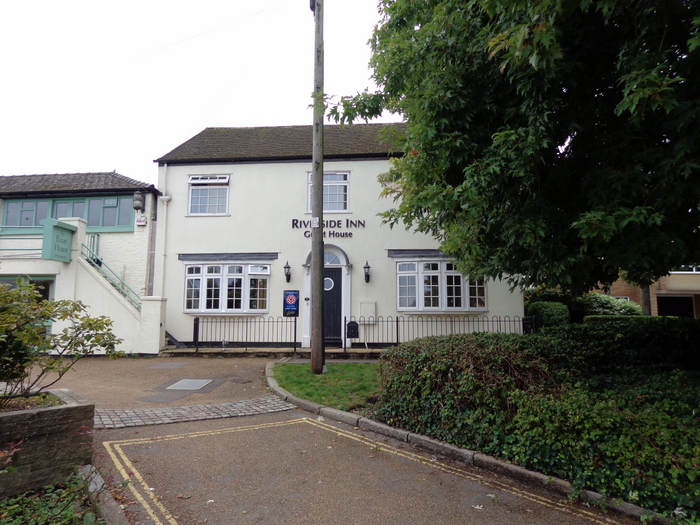 had its own engine built in. We will
be going back to Peterborough tomorrow for our tour of the cathedral.
It is about ½ hour ride.
had its own engine built in. We will
be going back to Peterborough tomorrow for our tour of the cathedral.
It is about ½ hour ride.
We arrived in Ely and took a taxi to the Riverside Inn Guest House where
we had reservation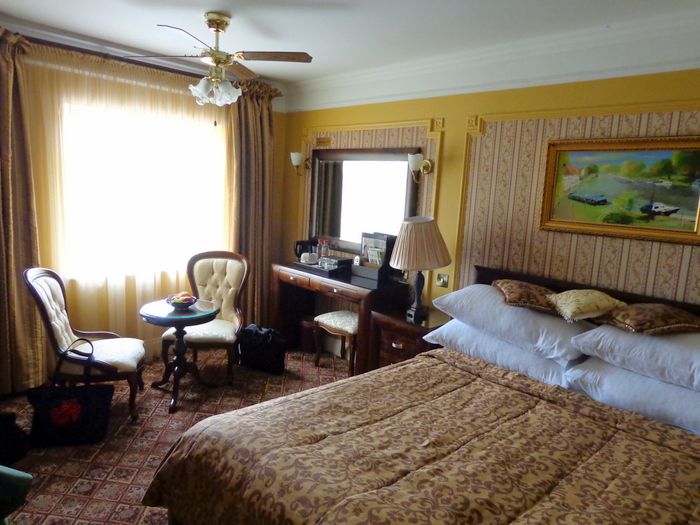 s. It is small but a well appointed inn with about 6
rooms –like a bed and breakfast as we do get breakfast.
s. It is small but a well appointed inn with about 6
rooms –like a bed and breakfast as we do get breakfast.
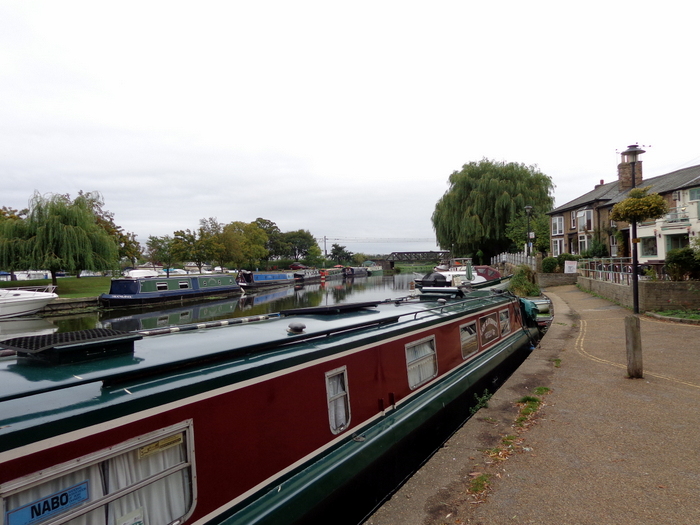 We are on the
bend of the river which has a lot of small house barges and other boat
tied up. We will be here for three nights. We walked through a nice
park to the cathedral. We didn’t see any place to eat. We had bought a
nice large muffin in Peterborough so that had to last us.
We are on the
bend of the river which has a lot of small house barges and other boat
tied up. We will be here for three nights. We walked through a nice
park to the cathedral. We didn’t see any place to eat. We had bought a
nice large muffin in Peterborough so that had to last us.
We had a 2:15 appointment for a tour. Again we got a private tour as
guests of the Dean, who was out of town. Our guide, Tony Hull, was an
attractive fellow with gray hair, but younger than me.
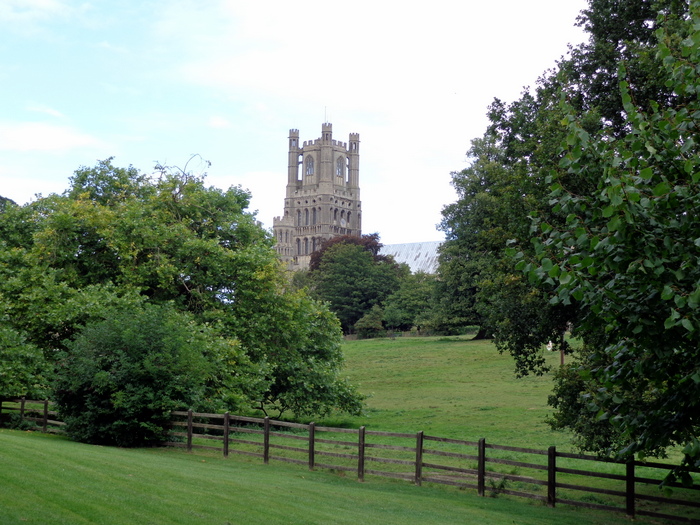 There has been a church in Ely since Christianity first came to
England. A monastery had been built in Ely in honor of St. Mary by St.
Augustine, who brought Christianity to southern England in 597.
There has been a church in Ely since Christianity first came to
England. A monastery had been built in Ely in honor of St. Mary by St.
Augustine, who brought Christianity to southern England in 597.
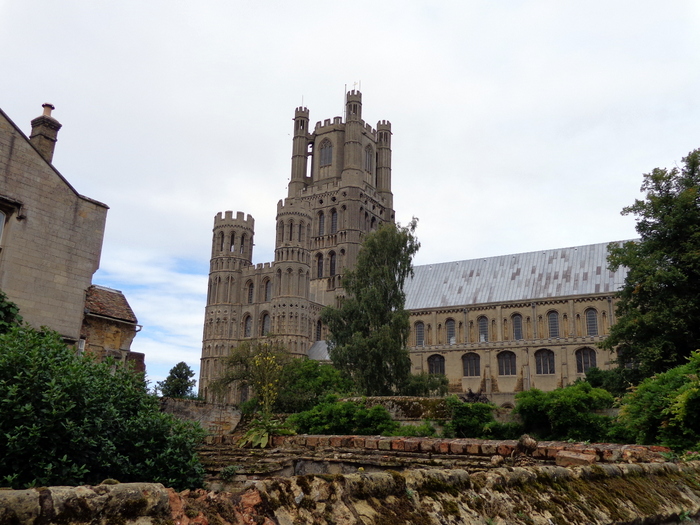 There
were Christians already in England. We know that three English bishops
attended the Council of Arles in 313.
There
were Christians already in England. We know that three English bishops
attended the Council of Arles in 313.
About 70 years after the founding of the monastery, a Saxon Princess
desired to enter religious life. Etheldreda, the daughter of Anna, King
of the East Angles, became an ardent Christian like her father. After
12 years of an unhappy marriage, she retired to a convent to become a
nun. In 673 she founded a double monastery for men and women. She was
abbesses for only seven years and died of a tumor in the neck and was
buried in the simple grave. Her sister, who succeeded her, exhumed her
body and moved it into the church. Contemporary accounts relate that
the body was incorrupt and that the tumor had been healed. Etheldreda
soon was acknowledged a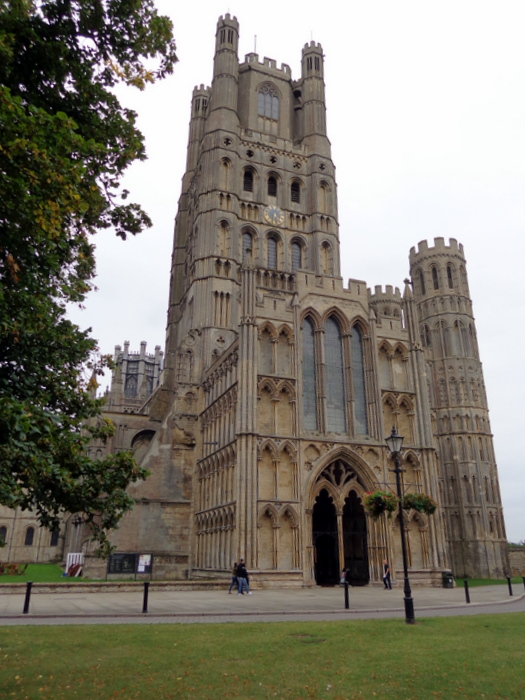 saint and Ely became a place of pilgrimage, a
tradition that has recently been revived with the annual St. Etheldreda
pilgrimage on the Sunday nearest to June 23, her feast day. She is
depicted in several windows and carvings in the Cathedral.
saint and Ely became a place of pilgrimage, a
tradition that has recently been revived with the annual St. Etheldreda
pilgrimage on the Sunday nearest to June 23, her feast day. She is
depicted in several windows and carvings in the Cathedral.
St. Etheldreda's church, in the monastery was destroyed by the Vikings
when they invaded England in 869 and remained in ruins until the
monastery was refoun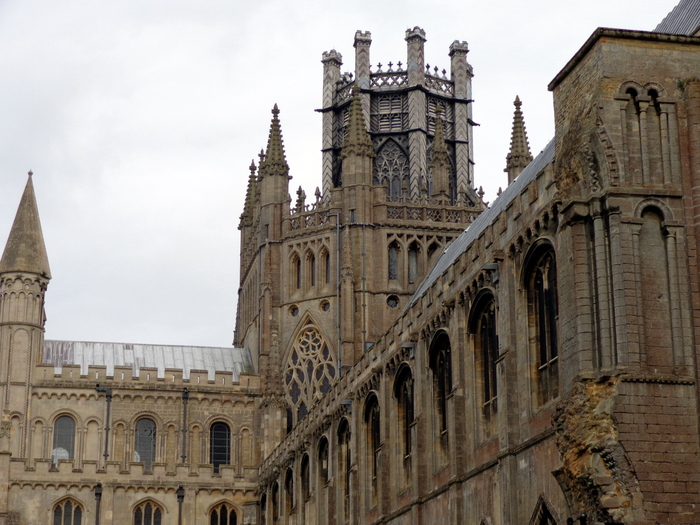 ded. It became a Benedictine Abbey for men only and
the monastic life was lived in Ely under the rule of St. Benedict for
570 years until the Dissolution of the Monasteries 1539. Chapel of St.
Dunstan and St. Ethelwold
ded. It became a Benedictine Abbey for men only and
the monastic life was lived in Ely under the rule of St. Benedict for
570 years until the Dissolution of the Monasteries 1539. Chapel of St.
Dunstan and St. Ethelwold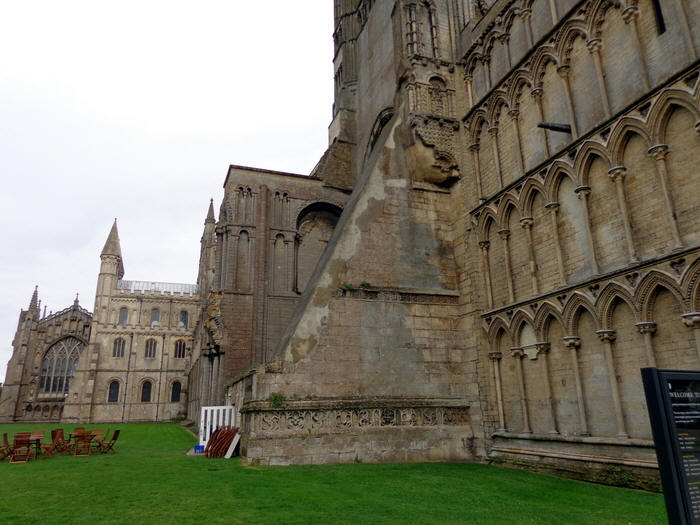 in the South transept of the Cathedral
commemorates the two Saints who were responsible for the restoration of
the monastery.
in the South transept of the Cathedral
commemorates the two Saints who were responsible for the restoration of
the monastery.
In 1109 the Abbey became a Cathedral. The Abbott became the Bishop of
the new diocese of Ely. The success of Ely as a place of pilgrimage
required the remodeling of the area around the shrine in order to
provide accommodations for the pilgrims. The East End was rebuilt in
the 13th century to provide a much larger space for the pilgrims.
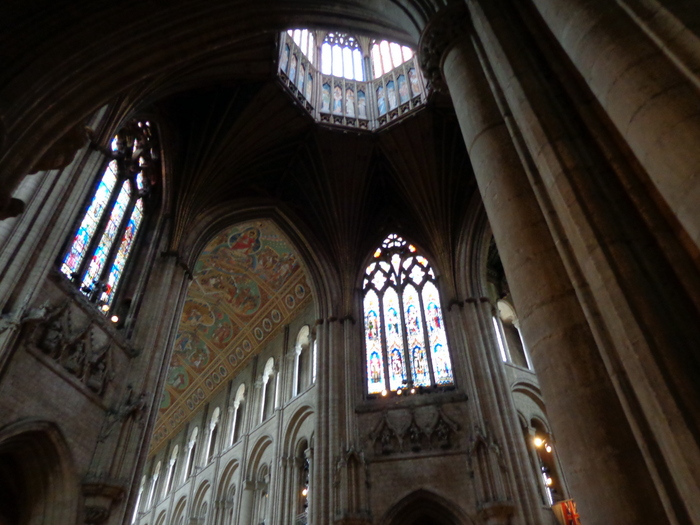
In 1322, only 70 years after the Presbytery or the sanctuary was
finished, the sqare Norman central tower collapsed. It was replaced by
an octagonal lantern Tower o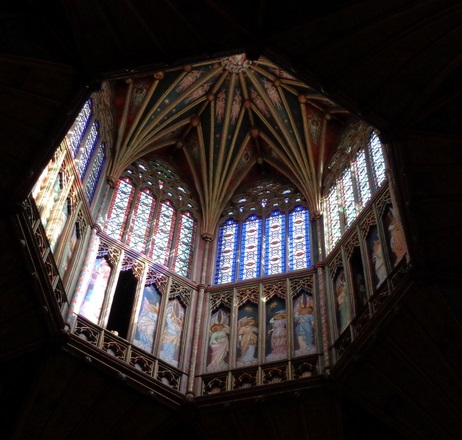 ver 60 feet high. It took 16 years to
build. Today the altar for the Sunday Eucharist is situated under the
Octagon.
ver 60 feet high. It took 16 years to
build. Today the altar for the Sunday Eucharist is situated under the
Octagon.
The 13th and 14th century saw the rise of the cult of the
Virgin Mary, especially in England, and Lady Chapels in her honor were
added to many churches. There was already a small Lady Chapel in Ely
but it was not large enough, so a new one was built on the north side of
the Presbytery or Sanctuary. The Lady Chapel of Ely, the largest
attached to any British Cathedral, is exceptional. It was built at the
same time as the Octagon and was co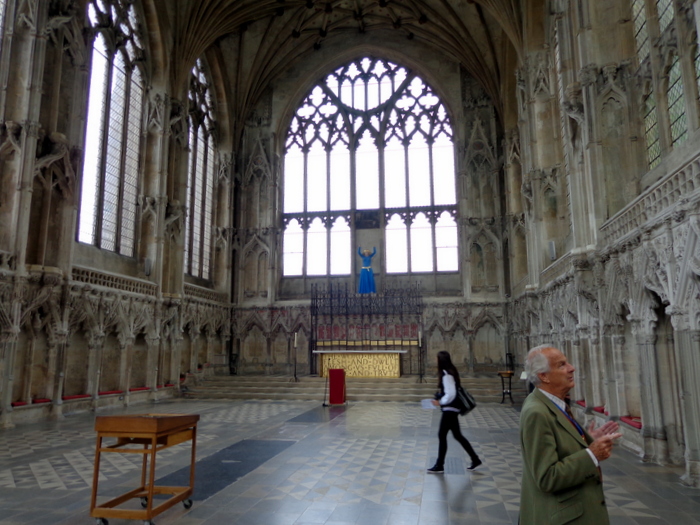 mpleted in 1349. It took 28 years to
build.
mpleted in 1349. It took 28 years to
build.
When completed, the chapel looked very different from the way it does
today. It was highly colored, the windows were fille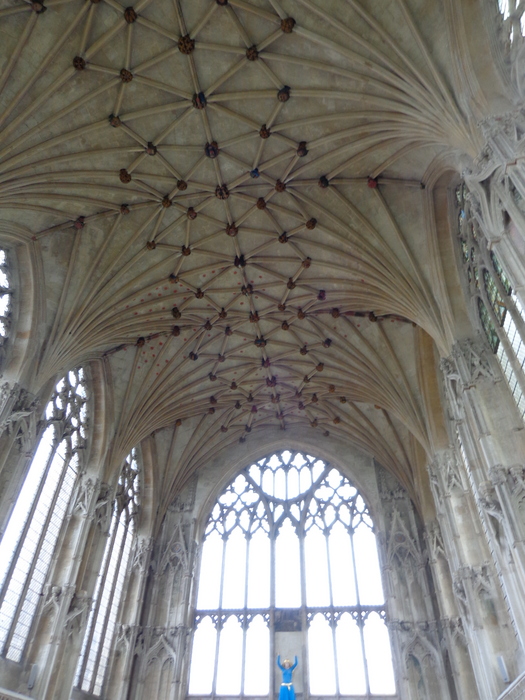 d with
stained-glass and there were painted statues in the niches. All of this was destroyed in the Reformation. The windows are now plain glass,
all the figures in the lower niches have been defaced, and above are
the empty pedestals where the saints once stood. Some of the coloring
can still be seen. In the Lady Chapel is a new
d with
stained-glass and there were painted statues in the niches. All of this was destroyed in the Reformation. The windows are now plain glass,
all the figures in the lower niches have been defaced, and above are
the empty pedestals where the saints once stood. Some of the coloring
can still be seen. In the Lady Chapel is a new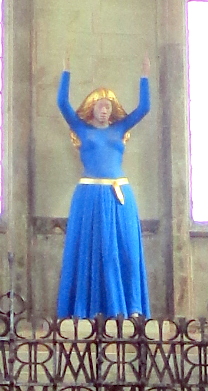 statue of Mary by David
Wynne which was installed above the altar in the year 2000. It is
carved from Portland stone and weighs half a ton. The sculptor shows
her as very expressive with her hands raised exulting in the news that
she was to be the mother of Jesus. She is dressed in a modern flowing
blue gown.
statue of Mary by David
Wynne which was installed above the altar in the year 2000. It is
carved from Portland stone and weighs half a ton. The sculptor shows
her as very expressive with her hands raised exulting in the news that
she was to be the mother of Jesus. She is dressed in a modern flowing
blue gown.
The end of the 18th century, the Cathedral was in a disgraceful
condition. The early Victorian period saw a reawakening in the
importance of cathedrals and church architecture. In 1839 a new Dean,
George Peacock, set about a major restorat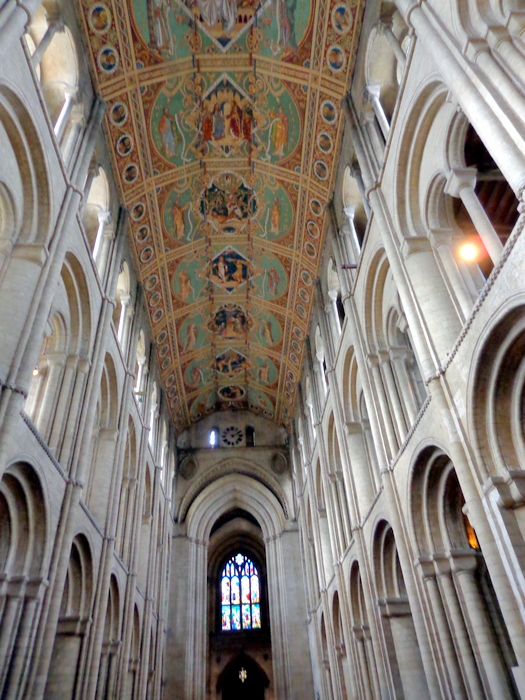 ion. In addition to
rearrangements of the choir and the organ, one of the most notable
improvements was to construct the remarkable painted ceiling in the
Nave. The medieval rafters were covered with planks and were painted by
two Victorian artists who did it as a labor of love. The ceiling tells
the story of the ancestry of Jesus, beginning with Adam continuing
through David. The last four panels have New Tes
ion. In addition to
rearrangements of the choir and the organ, one of the most notable
improvements was to construct the remarkable painted ceiling in the
Nave. The medieval rafters were covered with planks and were painted by
two Victorian artists who did it as a labor of love. The ceiling tells
the story of the ancestry of Jesus, beginning with Adam continuing
through David. The last four panels have New Tes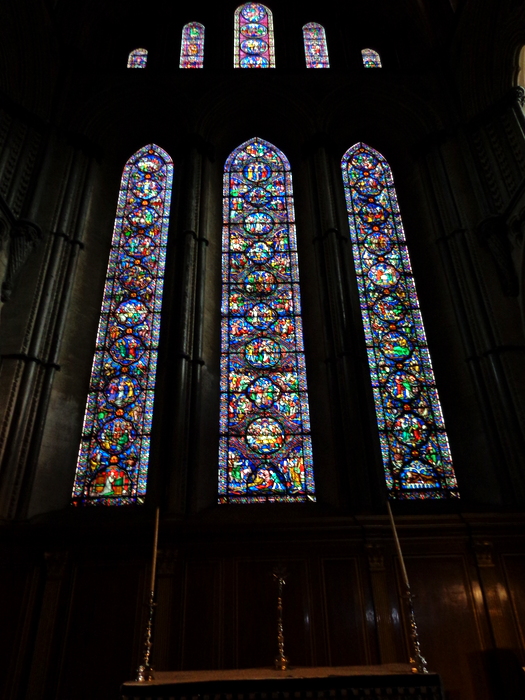 tament themes: the
Annunciation, the Nativity, the Adoration of the Magi and Christ in
Majesty.
tament themes: the
Annunciation, the Nativity, the Adoration of the Magi and Christ in
Majesty.
Ely Cathedral has exquisite stained-glass windows. An example is the
window at the very east end in the St. Etheldreda Chapel.
On a wall near the West entrance is a modern sculpture symbolizing
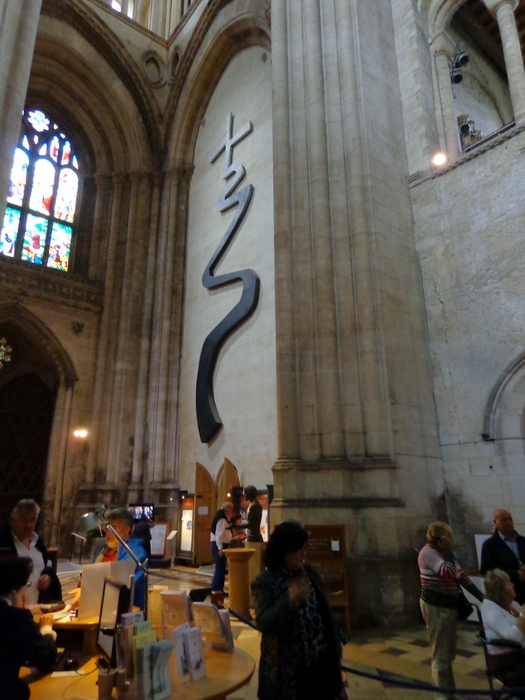 The
Way of Life by Jonathan Clarke. It is in cast aluminum with nine
sections, each differently jointed. " Like the journey of life, it's
path is irregular and unpredictable, and as the journey is sometimes
hard, somewhat joyful, so the surface texture in the colors are also
varied. Perhaps to give human scale to the journey, Jonathan Clarke
placed a tiny human figure on the top arm of the cross" (Ely Cathedral
Guide Book)
The
Way of Life by Jonathan Clarke. It is in cast aluminum with nine
sections, each differently jointed. " Like the journey of life, it's
path is irregular and unpredictable, and as the journey is sometimes
hard, somewhat joyful, so the surface texture in the colors are also
varied. Perhaps to give human scale to the journey, Jonathan Clarke
placed a tiny human figure on the top arm of the cross" (Ely Cathedral
Guide Book)
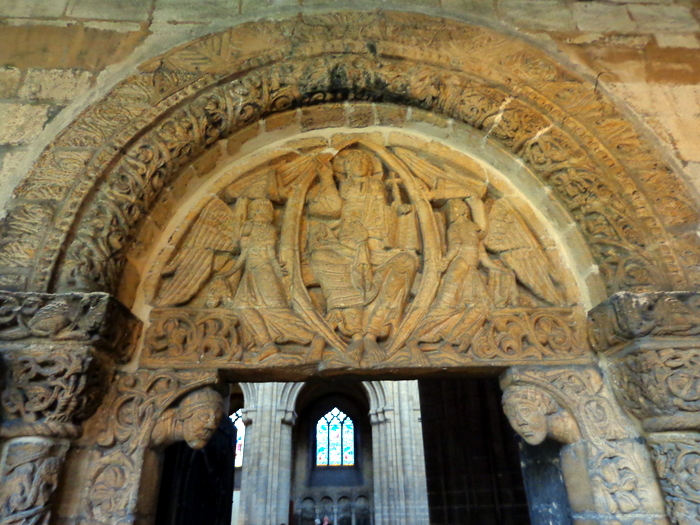 There
is a door on the south side of the nave, known as The Prior's Door
with a beautifully carved portal believed to date from c. 1120 – 1140.
The tympanum over the door shows Christ enthroned in Majesty. His right
hand is raised in blessing and his left hand holds the Book with the
Seven Seals, the record of good and evil deeds. Around the doorway the
carvings depict the signs of the zodiac, and of the labors of the
months.
There
is a door on the south side of the nave, known as The Prior's Door
with a beautifully carved portal believed to date from c. 1120 – 1140.
The tympanum over the door shows Christ enthroned in Majesty. His right
hand is raised in blessing and his left hand holds the Book with the
Seven Seals, the record of good and evil deeds. Around the doorway the
carvings depict the signs of the zodiac, and of the labors of the
months.
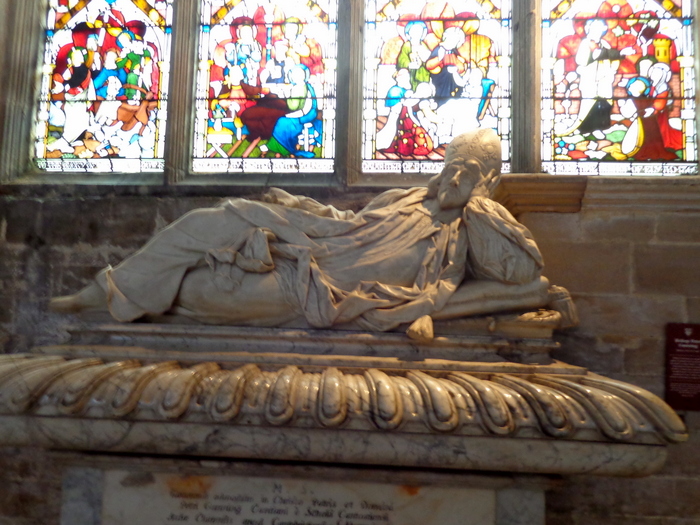
There are
several interesting tombs around the cathedral. One of my favorite was
a memorial to Bishop Peter Gunning, Bishop from 1675 -1684.
Our guide, Tony, gave us an excellent and memorable several hour tour of
Ely.
MY ELY CATHEDRAL MODEL
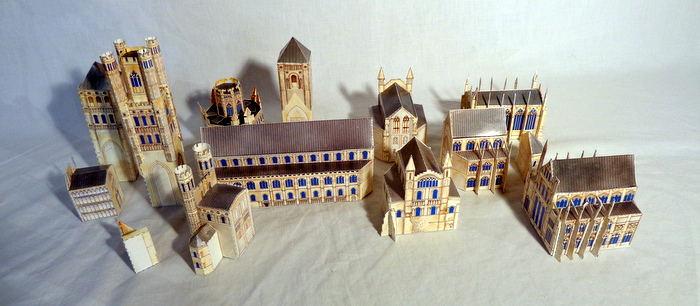 The exterior of the church was quite remarkable. I bought a model kit
which had parts to assemble from various periods of the building. Pictured
above are the various components.
The exterior of the church was quite remarkable. I bought a model kit
which had parts to assemble from various periods of the building. Pictured
above are the various components.
This photo
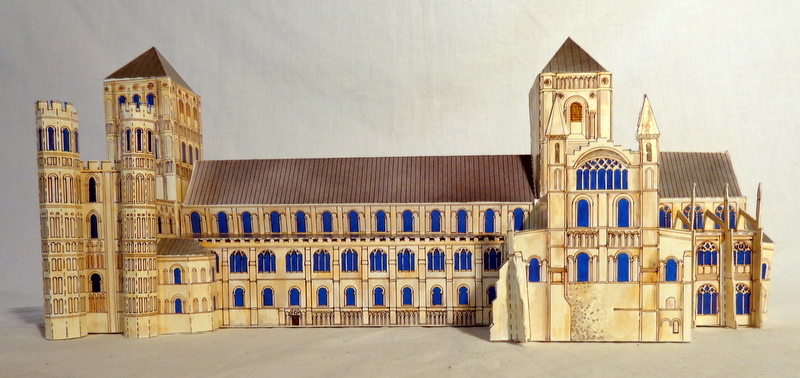 shows
the cathedral with the square tower in the crossing and over the
west front. At the right end the apse can be seen.
shows
the cathedral with the square tower in the crossing and over the
west front. At the right end the apse can be seen.
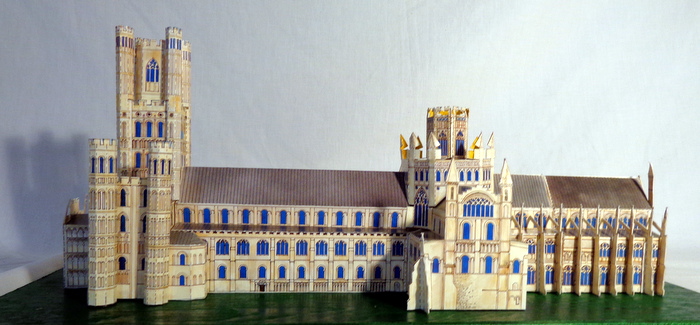 The
photo belows shows the cathedral as it is after all additions - the
Octagon Tower, the new West Tower, the East End addition for the St.
Etheldreda Chapel and the addition of a Galillee porch on the West
Facade.
The
photo belows shows the cathedral as it is after all additions - the
Octagon Tower, the new West Tower, the East End addition for the St.
Etheldreda Chapel and the addition of a Galillee porch on the West
Facade.
This photo
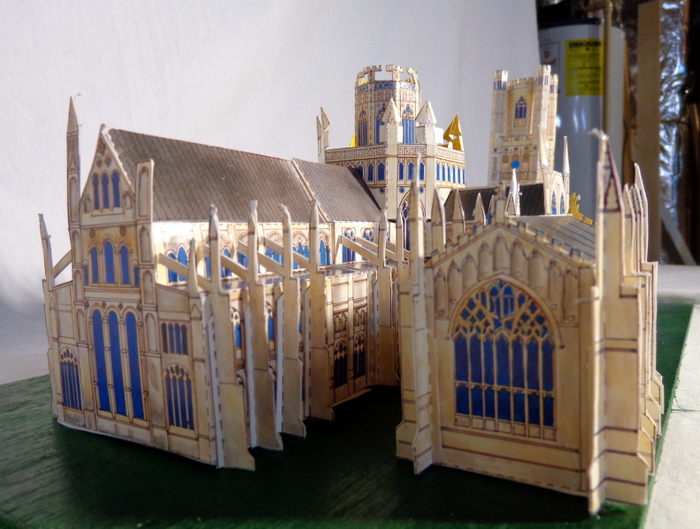 is
of the East End Chapel with the beautiful windows in the center in the
St. Etheldreda Chapel. The structure on the right is the
Lady Chapel.
is
of the East End Chapel with the beautiful windows in the center in the
St. Etheldreda Chapel. The structure on the right is the
Lady Chapel.
We walked several blocks around the cathedral, stopped for a drink and a
cheese p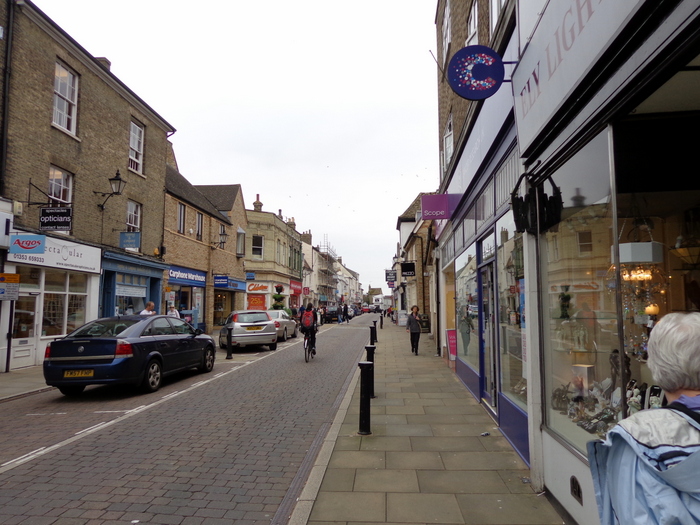 latter in an old hotel, then walked back to our room.
latter in an old hotel, then walked back to our room.
There is
a nice restaurant, The Boat House, next door to our Inn, but it didn’t open
until 6:30. I went over and made reservations for 7:30.
We enjoyed a wonderful dinner at the Boat House. For starters we shared
baked mushrooms in a cream sauce with cheese on top. For the main
course we shared a slow roasted lamb shoulder with new potatoes, carrots
and sautéed cabbage. It was listed to share…it would have been enough
for three maybe four. It was delicious. For dessert we share a lemon
posset with berries. It came in a glass mug with berries and the lemon
cream below. As the English say: “it was lovely”.

 had its own engine built in. We will
be going back to Peterborough tomorrow for our tour of the cathedral.
It is about ½ hour ride.
had its own engine built in. We will
be going back to Peterborough tomorrow for our tour of the cathedral.
It is about ½ hour ride.
 s. It is small but a well appointed inn with about 6
rooms –like a bed and breakfast as we do get breakfast.
s. It is small but a well appointed inn with about 6
rooms –like a bed and breakfast as we do get breakfast.
 We are on the
bend of the river which has a lot of small house barges and other boat
tied up. We will be here for three nights. We walked through a nice
park to the cathedral. We didn’t see any place to eat. We had bought a
nice large muffin in Peterborough so that had to last us.
We are on the
bend of the river which has a lot of small house barges and other boat
tied up. We will be here for three nights. We walked through a nice
park to the cathedral. We didn’t see any place to eat. We had bought a
nice large muffin in Peterborough so that had to last us.
 There has been a church in Ely since Christianity first came to
England. A monastery had been built in Ely in honor of St. Mary by St.
Augustine, who brought Christianity to southern England in 597.
There has been a church in Ely since Christianity first came to
England. A monastery had been built in Ely in honor of St. Mary by St.
Augustine, who brought Christianity to southern England in 597.
 There
were Christians already in England. We know that three English bishops
attended the Council of Arles in 313.
There
were Christians already in England. We know that three English bishops
attended the Council of Arles in 313.
 saint and Ely became a place of pilgrimage, a
tradition that has recently been revived with the annual St. Etheldreda
pilgrimage on the Sunday nearest to June 23, her feast day. She is
depicted in several windows and carvings in the Cathedral.
saint and Ely became a place of pilgrimage, a
tradition that has recently been revived with the annual St. Etheldreda
pilgrimage on the Sunday nearest to June 23, her feast day. She is
depicted in several windows and carvings in the Cathedral.
 ded. It became a Benedictine Abbey for men only and
the monastic life was lived in Ely under the rule of St. Benedict for
570 years until the Dissolution of the Monasteries 1539. Chapel of St.
Dunstan and St. Ethelwold
ded. It became a Benedictine Abbey for men only and
the monastic life was lived in Ely under the rule of St. Benedict for
570 years until the Dissolution of the Monasteries 1539. Chapel of St.
Dunstan and St. Ethelwold in the South transept of the Cathedral
commemorates the two Saints who were responsible for the restoration of
the monastery.
in the South transept of the Cathedral
commemorates the two Saints who were responsible for the restoration of
the monastery.

 ver 60 feet high. It took 16 years to
build. Today the altar for the Sunday Eucharist is situated under the
Octagon.
ver 60 feet high. It took 16 years to
build. Today the altar for the Sunday Eucharist is situated under the
Octagon. mpleted in 1349. It took 28 years to
build.
mpleted in 1349. It took 28 years to
build.
 d with
stained-glass and there were painted statues in the niches. All of this was destroyed in the Reformation. The windows are now plain glass,
all the figures in the lower niches have been defaced, and above are
the empty pedestals where the saints once stood. Some of the coloring
can still be seen. In the Lady Chapel is a new
d with
stained-glass and there were painted statues in the niches. All of this was destroyed in the Reformation. The windows are now plain glass,
all the figures in the lower niches have been defaced, and above are
the empty pedestals where the saints once stood. Some of the coloring
can still be seen. In the Lady Chapel is a new statue of Mary by David
Wynne which was installed above the altar in the year 2000. It is
carved from Portland stone and weighs half a ton. The sculptor shows
her as very expressive with her hands raised exulting in the news that
she was to be the mother of Jesus. She is dressed in a modern flowing
blue gown.
statue of Mary by David
Wynne which was installed above the altar in the year 2000. It is
carved from Portland stone and weighs half a ton. The sculptor shows
her as very expressive with her hands raised exulting in the news that
she was to be the mother of Jesus. She is dressed in a modern flowing
blue gown.
 ion. In addition to
rearrangements of the choir and the organ, one of the most notable
improvements was to construct the remarkable painted ceiling in the
Nave. The medieval rafters were covered with planks and were painted by
two Victorian artists who did it as a labor of love. The ceiling tells
the story of the ancestry of Jesus, beginning with Adam continuing
through David. The last four panels have New Tes
ion. In addition to
rearrangements of the choir and the organ, one of the most notable
improvements was to construct the remarkable painted ceiling in the
Nave. The medieval rafters were covered with planks and were painted by
two Victorian artists who did it as a labor of love. The ceiling tells
the story of the ancestry of Jesus, beginning with Adam continuing
through David. The last four panels have New Tes tament themes: the
Annunciation, the Nativity, the Adoration of the Magi and Christ in
Majesty.
tament themes: the
Annunciation, the Nativity, the Adoration of the Magi and Christ in
Majesty.
 The
Way of Life by Jonathan Clarke. It is in cast aluminum with nine
sections, each differently jointed. " Like the journey of life, it's
path is irregular and unpredictable, and as the journey is sometimes
hard, somewhat joyful, so the surface texture in the colors are also
varied. Perhaps to give human scale to the journey, Jonathan Clarke
placed a tiny human figure on the top arm of the cross" (Ely Cathedral
Guide Book)
The
Way of Life by Jonathan Clarke. It is in cast aluminum with nine
sections, each differently jointed. " Like the journey of life, it's
path is irregular and unpredictable, and as the journey is sometimes
hard, somewhat joyful, so the surface texture in the colors are also
varied. Perhaps to give human scale to the journey, Jonathan Clarke
placed a tiny human figure on the top arm of the cross" (Ely Cathedral
Guide Book) There
is a door on the south side of the nave, known as The Prior's Door
with a beautifully carved portal believed to date from c. 1120 – 1140.
The tympanum over the door shows Christ enthroned in Majesty. His right
hand is raised in blessing and his left hand holds the Book with the
Seven Seals, the record of good and evil deeds. Around the doorway the
carvings depict the signs of the zodiac, and of the labors of the
months.
There
is a door on the south side of the nave, known as The Prior's Door
with a beautifully carved portal believed to date from c. 1120 – 1140.
The tympanum over the door shows Christ enthroned in Majesty. His right
hand is raised in blessing and his left hand holds the Book with the
Seven Seals, the record of good and evil deeds. Around the doorway the
carvings depict the signs of the zodiac, and of the labors of the
months.
 The exterior of the church was quite remarkable. I bought a model kit
which had parts to assemble from various periods of the building. Pictured
above are the various components.
The exterior of the church was quite remarkable. I bought a model kit
which had parts to assemble from various periods of the building. Pictured
above are the various components. shows
the cathedral with the square tower in the crossing and over the
west front. At the right end the apse can be seen.
shows
the cathedral with the square tower in the crossing and over the
west front. At the right end the apse can be seen. The
photo belows shows the cathedral as it is after all additions - the
Octagon Tower, the new West Tower, the East End addition for the St.
Etheldreda Chapel and the addition of a Galillee porch on the West
Facade.
The
photo belows shows the cathedral as it is after all additions - the
Octagon Tower, the new West Tower, the East End addition for the St.
Etheldreda Chapel and the addition of a Galillee porch on the West
Facade. is
of the East End Chapel with the beautiful windows in the center in the
St. Etheldreda Chapel. The structure on the right is the
Lady Chapel.
is
of the East End Chapel with the beautiful windows in the center in the
St. Etheldreda Chapel. The structure on the right is the
Lady Chapel. latter in an old hotel, then walked back to our room.
latter in an old hotel, then walked back to our room.

